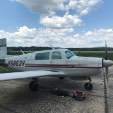Aircraft jacking poll
Aircraft jacking using a weighted tail stand Vs using a cable winch
51 members have voted
-
1. When jacking your Mooney what method do you use?
-
Weighted tail stand38
-
Engine hoist on engine hoist point11
-
Engine hoist lifting on prop blades2
-
-
2. Have you incurred damage on your aircraft from any jacking incident?
-
Yes0
-
No51
-
Other with a story to tell0
-


Recommended Posts
Join the conversation
You can post now and register later. If you have an account, sign in now to post with your account.